


©Henskens Fossils & John v. Straaten
What is a fossil? 


©Henskens Fossils & John v. Straaten
A fossil is any evidence of prehistoric life.
This evidence can consist of actual remains, like bones, teeth etc., but also prints (e.g.from leaves) and foot prints.
Below Amphibian tracks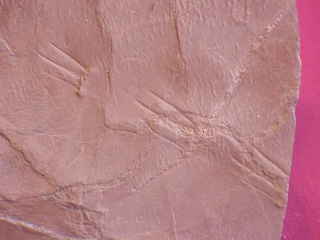
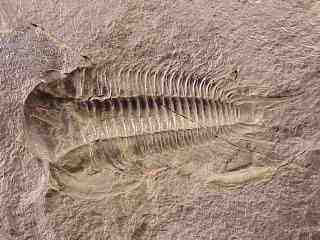
Above negative! imprint of Paradoxides gracilis
Paleontologyis the study of fossils. This is often confused with archaeology, the study of the rise ofhumans and their cultures. The paleontology studies the period between the origin of life(approximately 3.7 billion years ago) and the rise of the human culture about 10,000 yearsago.
Fossilshave intrigued man for generations. The Greek philosophers saw them as curious, naturalphenomena that were formed in the earth the same way as crystals. Some people also thoughtthey were proof of the biblical Flood. Leonardo da Vinci (1452-1519) suggested in hisnotebooks (correctly) that fossils were the remains of organisms that once lived, and thathad turned to stone. In his time, his view was heretical; God would never allow his owncreations to become extinct. His notes were suppressed, until they were published in the19th century.
How is afossil formed?
A fossil isformed when the remains of plants and animals are not eaten by scavengers or bacteria, butare covered by sand, soil, volcanic ashes, mud etc. soon after their death, so that oxygencannot reach it. Usually only the hard parts of an organism will fossilize, like thebones. Only very rarely will softer parts fossilize.
Thefollowing processes can lead to fossilization:
How is theage determined?
This isoften done by measuring the lead – uranium ratio in fossil bearing rocks. Veryslowly, uranium turns into lead, with a half-life of millions of years. This means thatyou can get a relatively accurate dating by measuring the ratio of these two elements. Thehalf-life is the time it takes for 50 % of the radioactive element to change into astable, non-radioactive element.
The ratiobetween other radioactive and non-radioactive elements can also be used, e.g. betweenrubidium and strontium (rubidium changes into strontium) and potassium and argon(potassium changes into argon). Fifty percent of uranium 238 changes into lead 206 inapproximately 4.5 billion years, 50 % of uranium 235 in 704 million years into lead 207,50 % of thorium 232 in 14 billion years into lead 208, 50 % of rubidium 87 in 49 billionyears into strontium 87, 50 % of potassium 40 in 1.25 billion years into argon 40, and 50% of carbon in 5570 years into nitrogen. These radioactive elements were built when oursolar system was formed and are in our atmosphere. When rocks are formed, they are‘captured’ in these rocks and start to change into non-radioactive elements.
To takecarbon as example: in 5570 years, half of the carbon is converted into nitrogen. For theremaining 50 %, it takes another 5570 years before half of it is converted into nitrogen.Now 25 % of the original amount of carbon is left. After another 5570 years, 1/8 remains,then 1/16, then 1/32 etc. Because of this relatively fast rate, carbon dating can only beused for the last 70,000 years. This is why it is often used an archaeology.
Theabove-mentioned method is also called absolute dating. The so-called relative dating isalso often used. In this case, the age of a fossil is determined by using fossils from thesame layer that are very common but have lived for only a short period of time (so-calledtrace fossils like ammonites and snails). If a fossil fish is found in the same layer asan ammonite from which we already know it lived only during the Upper-Cretaceous, the fishmust be from the same period.
(Below Allocriaceras from the Upper Cretaceous).

Precambrian(4.6 billion years – 570 million years)
Mostcosmologists agree that the universe was formed about 15 billion years ago. Everything wascompressed into one block which had so much mass that at a certain moment it exploded; theBig Bang. A very weak microwave radiation, coming from all directions of the universe, isa remnant of that period. There is also other proof that the universe is still expandingin all directions.
The earthis about 4.6 billion years old. The moon and the planets seem to be of the same age. Thesun (a star) is older, because it was formed first after the Big Bang. From the remainingmatter the earth and other celestial bodies were formed. The oldest rocks on earth arefour billion years old, which means it took 600 million years before the earth was cooleddown enough to form the earth’s crust. At some places, this crust is 50 miles thick,while at other places it is so thin that lava flows out.
Theearth’s crust is divided into a number of bigger and smaller plates. Lava streamsupwards along the sides of these plates, pushing the plates apart. These plates also move(usually with only a few inches per year) because of the currents of the liquid rock inthe earth. Mountains are formed when two plates push against each other. In this way, theAlps were formed because of the ‘collision’ between Africa and southern Europe.The plates can also move along, from or under each other. If this happens with big jumps,it causes earthquakes.
Movingcontinents function as rafts, bringing animals and other organisms from one part of theworld to the other through the course of millions of years. In this way, continents cantraverse through climate zones. For example, the southern part of Africa moved to tropicallatitudes between the end of the Carboniferous and the end of the Triassic era. This hadmajor consequences for the plant and animal life on earth.
How thecontinents were once divided can be determined by using fossils from plants and animalsthat must have had only a small area of distribution (especially from organism livingalong coasts), but from which the fossils are now found thousands of miles apart. Becausefossils from the Precambrian are rare, we can only make a reconstruction of the divisionof continents beginning from the Cambrian.
From ageological viewpoint, life was formed very fast after the earth was cooled down. Theoldest life forms are approximately 3.7 billion years old. In a unknown way, single-celledorganisms were formed from chemical reactions in sea water. These were co-calledProkaryotes, which did not have a nucleus yet. Around this time, the first algae appear,so-called stromatoliths, built by layers of Prokaryotes. The first single-celled organismswith a nucleus were formed 2.1 billion years ago, the so-called
Eukaryotes (Right an organism with nucleated cells).
We willprobably never find out how life was formed. But the fact that the earth contains life isjust a coincidence. All conditions for life are present on earth: enough sun light, thecorrect temperature, and water. For the formation and development of life we first need astable mother star (in our case the sun), that delivers a constant flow of energy forbillions of years. Life is than possible on a planet that is not too close to that star(otherwise it will be too hot) and not too far away (otherwise it will be too cold). Themass of the sun is also very important. If it would be 30 % more than it is now, the sunwould be burned out after four billion years. Luckily, our sun will last for another fivebillion years or so, which means we are halfway now. Another condition is a very bigplanet like Jupiter which ensures that a small and vulnerable planet like the earth isfairly safe from comets and asteroids. The moon is also important. It makes sure that theposition of the earth’s axis remains stable.
Single-celledorganisms did not develop for two billion years, until multicellular organisms suddenlyappeared about one billion years ago (in 1998 in India, trace fossils of multicellularworm-like organisms have been found in petrified sea sand that are 1.1 billion years old).That is probably because at that time the atmosphere contained enough oxygen for‘higher’ organisms. During the era of the single-celled organisms, the earth wasstill free from oxygen. However, the single-celled organisms gave off oxygen(photosynthesis; plant cells take up carbon dioxide from the air, convert it intocarbohydrates and give off oxygen as a waste product). The ozone layer in our atmospherealso consists of oxygen (O3 instead of O2), and probable also played a major role, becauseozone protects life on earth from the ultraviolet radiation of the sun.
Nowadays,the Precambrian is divided into three periods by scientists: The Hadean is the period from4.6 to 3.7 billion years ago, in which there was no life yet. The Archean is the periodfrom 3.7 to 2.5 billion years ago, in which stable continents formed and from which thefirst single-celled fossils are fairly common. The Proterozoic is the period from 2.5billion to 570 million years ago, in which multicellular animals evolve.
About 570million years ago an explosion of new life occurred. This new period is called theCambrian.
Cambrian(570 – 505 million years) 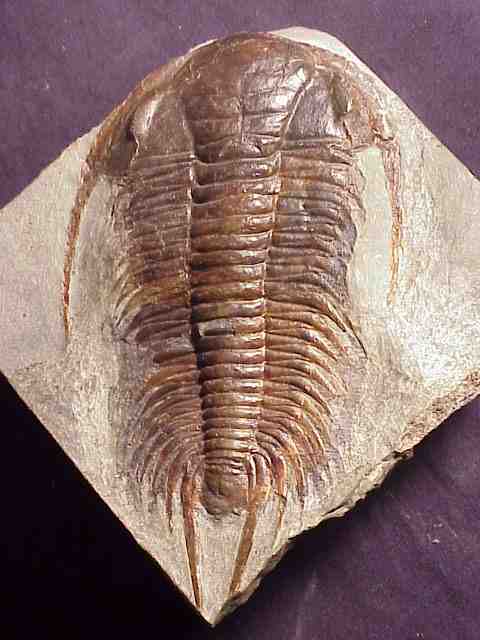 (Left Cambrian Trilobites Paradoxides gracilis)
(Left Cambrian Trilobites Paradoxides gracilis)
TheNorthern Hemisphere consists of the continents Laurentia, Baltica and Sibiria, and theSouthern Hemisphere of the supercontinent Gondwana, which includes current Africa, SouthAmerica, Antarctica, western Australia, India and southern Europe. Big land masses areunder water due to sea floodings. There are no continents around the poles.
The firstand widely spread fossils are from the Lower Cambrian era. The animals from this period(which only lived in the sea) had developed armatures (for support and protection againstpredators). Of course, their remains are better preserved than the softer animals from thePrecambrian.
Many lifeforms had already developed in the sea water. Most animals were plant eaters living fromalgae. The oceans were inhabited by seaweeds, brachiopods (sea animals resemblingmussels), sponges, worms, echinoderms, sea snails, jellyfishes, shellfishes, and segmentedarthropods, the trilobites (so called because their body consists of three parts,‘lobes’). From all life, the trilobites were the most developed. More than15,000 species are known, varying in length from one mm to more than two feet. During theCambrian, they accounted for approximately 60 % of the animal life.
At the endof the Cambrian the first fishes and vertebrates appeared. The spine served as protectionagainst compression, as a ‘hatstand’ for the organs, and as a place ofattachment for the muscles.
Detransition from the Cambrian to the Ordovician is characterized by the extinction of a lotof animal species. Others dramatically decrease in number, especially the trilobites,until then dominating. They will never reach their great versatility again.
Ordovician(505 – 438 million years)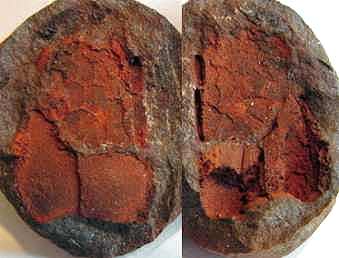 (Left Ordovician CarpoidMytrocystites)
(Left Ordovician CarpoidMytrocystites)
Thenorthern part of what is now Central Europe separates from Gondwana and consolidates withBaltica into what is now northern Europe at the end of the Ordovician. Present southernEurope is still part of Gondwana, and is situated near the South Pole.
In theOrdovician, the first organisms conquer the land. The shallow seas of the Cambrian dry upduring the outgoing tide, and blue-green algae are forced to survive without water for ashort time. They were capable of facing the air and the sunlight for a few hours duringthe tidal cycle, not more. But they did contribute to the existence of life on land.
Water is amixture of hydrogen and oxygen. By extracting hydrogen from water the blue-green algaereleased oxygen, which is essential for the production of energy that a lot of landanimals need in large quantities. They can also extract nitrogen from the air. Nitrogen isnecessary for building proteins, the materials of every organism. Thanks to the blue-greenalgae, the plants were able to move to land in the Ordovician. Saltwater plants moved tofresh water, and from there they reached the land.
Thetransition from the Ordovician to the Silurian is again characterized by largeextinctions, possibly resulting from the drifting continents around both poles. If thepole regions are covered by land (just like the South Pole by Antarctica now), the icelayers become very thick and extensive, and the sea levels will thus drop. Because of theoceanic and atmospheric circulations to the rest of the world, the temperatures willdecrease worldwide. This theory is supported by the fossils of the marine animals thathave been found from that period; the number of different species is small and adapted tocold water.
Silurian(438 – 408 million years)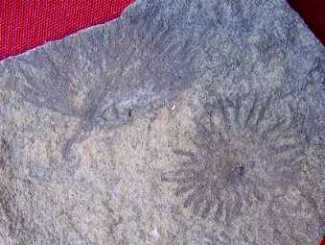 (LeftSilurian Graptolite Koremagraptus)
(LeftSilurian Graptolite Koremagraptus)
Laurentiaand present northern Europe come together and form the continent Euramerica.
The maindifference in the fauna from the Silurian compared to that of the Ordovician is thepresence of new families and genera, not so much the appearance of completely new animalgroups. An important new ‘invention’ is the development of jaws. They probablyevolved from the first row of gill arches. Until then, fishes had a mouth with which theycould suck in food. The development of jaws and teeth was very important for thevertebrates, because it meant they could eat more different kinds of food than jawlessanimals. A lot of different carnivores arose, which in turn forced their prey to improvethe ability to flee. The jawless fishes were partly or completely covered with bonyplates. The ‘new’ fishes with jaws developed scales.
In theSilurian the first real land plants appear (not more than two inches high), withwater-transporting tissue, a strong stem, and a wax-like outer layer to prevent waterloss. However, they are still connected to the water by their means of reproduction withspores. The first animals also move from the water to the land; insects (still withoutwings) like spiders, centipedes and wood louses. The first vertebrates on land appear inthe Devonian.
Devonian(408 – 360 million years) 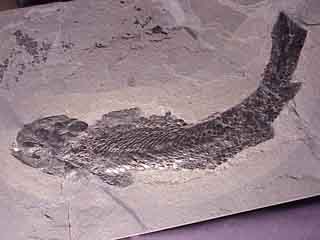 (Left DevonianFish Gyroptychius)
(Left DevonianFish Gyroptychius)
The firsttrees originated in the Devonian. The plants develop seeds, so that they are not dependenton water anymore for their reproduction and can conquer the inland. But it is mainly theage of the fishes. In this period the temperature rose, so that lakes and rivers dried up.Some freshwater fishes became extinct, but others were able to move from one pool to theother using fleshy fin lobes; with other words, they started to ‘walk’. Theseso-called lobe-finned fishes were the first fishes to develop lungs.
Thelungfish and the Coelacanth are examples of lobe-finned fishes that still live today.Lungfish are freshwater fishes and also have gills, but during a period of great droughttheir swimming bladder serves as a lung. They then bury themselves in the mud. They usetheir pectoral and pelvic fins as legs. The Coelacanth (a saltwater fish) was thought tobe extinct for millions of years already, until a living specimen and then a whole colonywas discovered near Madagascar in 1938.
Theamphibians evolved from the lobe-finned fishes. Amphibians like frogs and salamanders canlive both in water and on land, but their eggs are laid in water. They also depend onwater because of their skin. Although they have lungs, they also breath through theirsoft, wet skin. They have to make sure it doesn’t dry out.
Reptiles dono suffer from this problem. They breathe completely through their lungs, and lay eggswith a scale. Reptiles appeared in the Carboniferous.
Again, thetransition from the Devonian to the Carboniferous is characterized by wide extinctions.About 25 % of all families dies out. From the ammonites, fishes, amphibians, corals andtrilobites more than half of the families does not make it into the Carboniferous.
Carboniferous(360 – 285 million years)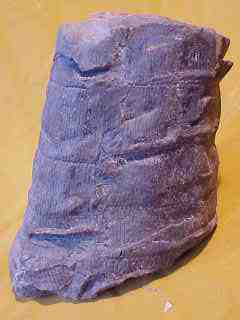 (LeftCarboniferous Plant Calamites)
(LeftCarboniferous Plant Calamites)
Gondwanaand Euramerica approach each other and ‘collide’ at the end of theCarboniferous, causing big mountain ranges in the areas that are now Central Europe andNorth America.
This era isnamed after the coal that is formed during that period. It was a time with shallow, warmseas. On land the amphibians further develop, while the plants grow in all humid areas.The coal deposits resulted from these swampy forests, with some trees reaching 160 feet.The slow armoured fishes become extinct, while the predators (sharks etc.) develop furtherand speed and manoeuvrability start to play an increasingly important role. The firstinsects with wings appear.
Thereptiles evolve from the amphibians. In the Upper Carboniferous they quickly spread outacross the land. Due to improvements in their jaws and teeth they developed to bigger andbetter carnivores. They put great pressure on their prey animals, which had to develop abetter defense or run harder. The development of eggs with a scale also played a majorrole. The eggs can now be laid on land, and the embryo is protected against dehydration.
Theimprovements to the jaw also enabled the reptiles to eat plants. The rise of theherbivorous reptiles meant a great incentive for the development of ecosystems on theland. The plants were forced to develop defense mechanisms. A tough cuticula (protectiveouter layer), leaves with a wax layer, sharp thorns and toxic substances probablyoriginated in this period.
But theherbivores also had a positive influence on the plants. Seeds with a tough skin could beeaten, pass the digestive tract of the animal unharmed, and be secreted in the middle of apile of dung, a perfect means of nutrition for the plants. In this way, the seeds could bespread across a wide area.
In turn,all kinds of different herbivores evolved that could eat the different plants, and thisresulted in a great variety of carnivores to hunt the herbivores. A very complex networkof evolutionary interactions formed on the land.
Permian (285– 245 million years)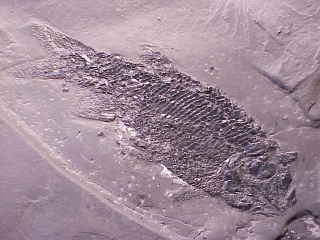 (Left Permian FishParamblypteris)
(Left Permian FishParamblypteris)
Allcontinents (except current Asia) come together and form the supercontinent Pangaea.Current central Europa lies near the equator, while current Africa, India, South Americaand Australia are covered by ice. The amphibians and reptiles now also spread acrossGondwana.
In thisperiod a lot of new insects appeared like beetles and dragonflies. The latter can reach awing span of more than two feet. Rivers and pools contain a wide variety of fishes.Amphibians thrive along the banks, but are already overshadowed by newer, more activereptiles.
One groupof carnivorous reptiles, the cynodonts, already had clear mammal-like characteristics.They were the first to be able to breathe and chew at the same time without choking,because the nasal passage was separated from the oral cavity. By chewing the food beforeswallowing the digestive process is accelerated. This suggests the cynodonts had to haveenergy at their disposal fast. It is possible they used it to produce their own body heat.As opposed to their predecessors they were small animals. A small animal with a bigsurface in relation to its body volume will lose heat fast. There is evidence thatcynodonts had hairs, so that they didn’t lose so much heat. The main characteristicsof modern mammals are hairs, the production of body heat (warm-bloodedness), and the factthat they feed their young with milk from mammary glands. The cynodonts, which still laideggs, seem to have passed the phase to real mammals for two-third.
The end ofthe Permian is also the end of the Paleozoic (‘first life’), which started withthe Cambrian. A lot of animal and plant species became extinct, such as the trilobites,the giant scale trees, most horsetails and a lot of ferns. Amphibians and some fishes weredramatically limited. This was caused by extreme climate changes. One of the reasons werethe drifting continents. In the Permian, the temperature on the southern continents rosebecause they moved north. Also, for the first time in history, the big land massesconnected to one supercontinent at the end of the Permian. Big, mobile animals couldspread out, resulting in less different types of animals.
So, thetransition from the Permian to the Triassic is again characterized by wide extinctions.More than 80 % of all animal and plant species died out. The Triassic is the beginning ofa period called Mesozoic (‘middle life’).
Triassic(245 – 208 million years)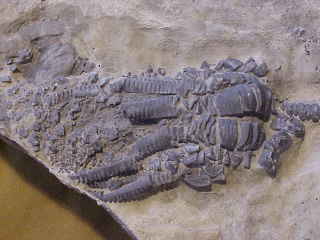 (LeftTriassic Crinoid Encrinus)
(LeftTriassic Crinoid Encrinus)
During theTriassic the reptiles not only spread out on land, but also in the water and in the air.Some reptiles decided to go back to the water, maybe because they could find more foodthere. The flying reptiles, the so-called pterosaurs, developed species with a wingspan of50 feet, as big as a glider plane. However, modern birds did not evolve from pterosaurs,but from land reptiles, most likely from dinosaurs. Pterosaurs and birds, which firstappeared in the Jurassic, together shared the air for almost 100 million years.
Thedinosaurs appeared in the Mid-Triassic. The difference with other reptiles is the factthat their legs stand directly under the body, and not sideways anymore. This made theirwalk more efficient, and a bigger body weight could be carried.
The firstreal mammals also appear in the Triassic. Their young already grew in the womb. Theadvantage is that they are already fairly big and strong when they are born. But under thedomination of the dinosaurs they stay only small and will only start to flourish after thedinosaurs have died out.
At the endof the Triassic there is another extinction wave, this time not so big. However,especially the ammonites, the amphibians and the reptiles on land suffer.
Dinosaurs(deinos sauros = Greek for ‘terrible lizard’)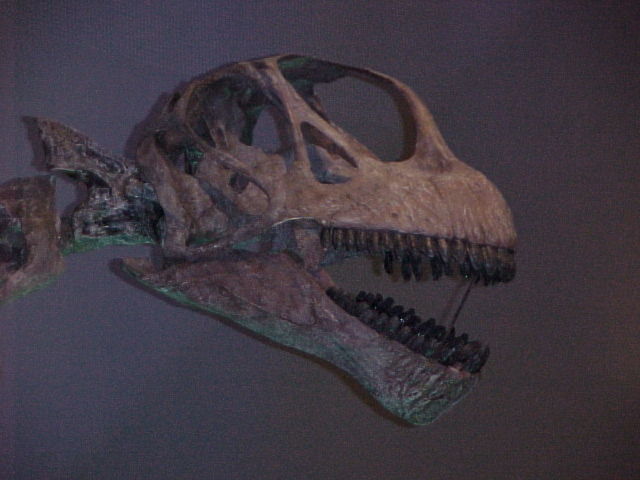 (Left Camarasaurus skull)
(Left Camarasaurus skull)
Dinosaursevolved from smaller reptiles approximately 230 million years ago. They differ from otherreptiles in the position of their legs: those of dinosaurs stand directly under theirbody, at other reptiles they stand sideways in a 90° angle. The advantage is the abilityto simultaneously breathe and run for a long time. Other reptiles cannot do this. Theirlung capacity is limited because of the constant bend of the body. Thanks to thiscompletely improved walk the dinosaurs could grow larger and run faster and harder. Thiscleared the evolutionary road for an enormous diversity in body types and lifestyles. Itshould be noted that dinosaurs only lived on land. Pterosaurs and reptiles living in waterare not dinosaurs.
During theTriassic there were no clues that they would soon rule the earth. At that time they wereinsignificant creatures, not bigger than a dog, surrounded by huge crocodiles and otherreptiles. But for evolutionary standards they must have taken over quickly. 220 Millionyears ago a lot of other reptiles declined, while the dinosaurs filled the empty spaces.The early mammals, that emerged around the same time as the dinosaurs, played only a minorrole for the next 165 million years.
The picturewe have from dinosaurs has changed in the last few decades. They were not necessarilydumb, and did not wander around on their own, also not the carnivores. They took care oftheir young and worked together to protect themselves against predators. Instead of aneven green or gray colour they could well have been brightly-coloured. New evidence evensuggests they were warm-blooded. They were agile animals that could even moveenergetically with cold weather and some even lived above the polar circle. Most dinosaurswere as big as a pony. The smallest was as big as a chicken, the biggest (found until now)could reach a length of 140 feet (Seismosaur).
We willlearn a lot more about dinosaurs this century, also since scientists discover a newspecies almost every few months. But two mysteries will probably never be solved.
The firstissue is the question if birds evolved from dinosaurs. Different fossils of possibleintermediate forms have been found. The most well-known of these is Archaeopteryx, ananimal the size of a pigeon, of which various fossils have been found in the 150 millionyear old Solnhofen limestone in Germany. The bone structure resembles that of a dinosaur.It also had a reptilian head with teeth. But it also had feathers and wings, although theystill had claws. One thing is sure though: birds did evolve from reptiles.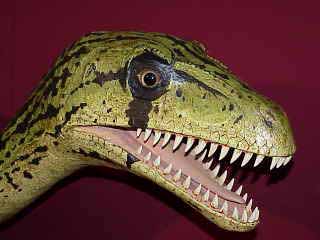 (Left Dinosaur Utah Raptor)
(Left Dinosaur Utah Raptor)
The secondmystery is the question how dinosaurs became extinct. The prevailing opinion nowadays isthat a big comet or asteroid hit the earth 65 million years ago. The resulting worldwidedust cloud obscured the sun for months or even years. Most vegetation died and thedinosaurs starved to death. The mammals now filled the empty spaces. This theory issupported by a thin layer of iridium, an element that is very rare at the surface of theearth but is fairly common in meteorites and asteroids, and that is found at the rightheight (at the border of the Cretaceous with the Tertiary) in the rock deposits.
On theMexican peninsula Yucatan scientists have discovered a (subterranean) crater impact thathas the ‘right’ dimensions and age. But there is also evidence that dinosaurswere disappearing anyway. The registration of fossils shows that the number of differentspecies decreased with 70 % between 73 and 65 million years ago. The flying and swimmingreptiles also declined in number. The cause of this decline is as yet unknown.
Jurassic(208 – 144 million years) 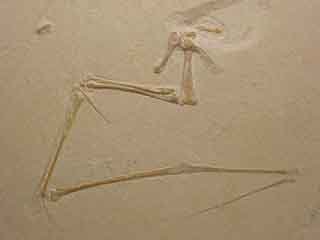 (leftUpper Jurassic Pterosaur Pterodactylus spec.)
(leftUpper Jurassic Pterosaur Pterodactylus spec.)
Pangaeaslowly starts to fall apart and new continents are being formed. Current North Americaseparates from Eurasia, thus forming the Atlantic Ocean. The overall climate is so warmthat the poles are free of ice.
Possiblyforced by the dinosaurs, more reptiles decide to go back to the sea. These reptiles evolveinto plesiosaurs, ichthyosaurs and mosasaurs. The dinosaurs prosper, and some species canreach a length of more than 100 feet.
A smallgroup of carnivorous reptiles, most possibly dinosaurs, now evolve into birds. They havereacted on a stimulation from the air, which had a rich food source in the form ofhundreds of different species of insects. The bird skeleton was built from light,air-filled bones, reptile scales changed into primitive feathers on body and tail, but theclaws still remained for a long time so that birds could climb into trees. These primitivebirds were probably not capable of flying off from the ground, but could glide from a treethrough the air for a short distance. After that, it was just a matter of time before thisshort gliding movement changed into real wing movements and birds really started to fly.
Cretaceous(144 – 65 million years)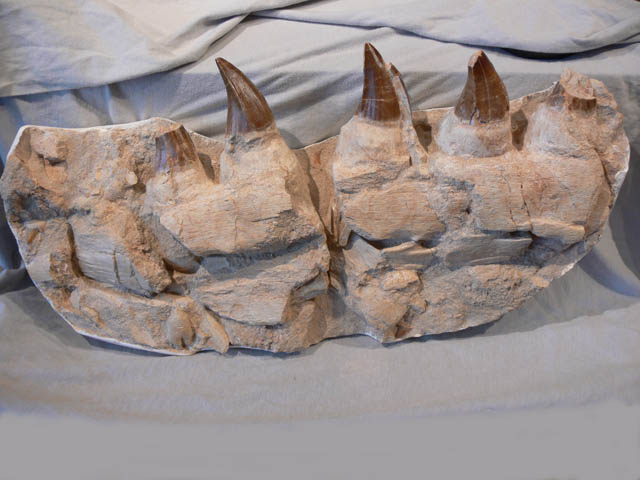 (Left Upper CretaceousMosasaur - jaw)
(Left Upper CretaceousMosasaur - jaw)
Gondwananow also breaks into pieces, which leads to the formation of Antarctica and Australia.India moves to the north and South America to the west. The Northern Hemisphere containstwo continents: Asiamerica, consisting of current Asia and the western part of NorthAmerica, and Euramerica, consisting of Europe and the eastern part of North America.
TheCretaceous was the forerunner of new plants and animals. The most important newcomers werethe flowering plants. Many trees and bushes from the this period still exist today. Thedinosaurs thrived, but became extinct at the end of the Cretaceous. This was probably agradual process, since plesiosaurs and other marine reptiles were already extinct in theMiddle Cretaceous. The pterosaurs, the remaining ammonites and some groups of bony fishesalso died out. The lizards, snakes, crocodiles, sea turtles, amphibians, mammals,bivalves, birds and most plants remained untouched.
Accordingto one of the first theories for this mass extinction, the atmosphere had changed becauseof high volcanic activity. This would be a disadvantage for the big reptiles, but anadvantage for the more lively mammals and birds. About 65 million years ago the so-calledDeccan Traps were formed in India. For a period of tens of thousands of years, lavastreamed from the earth. The gas and dust from these eruptions must have disturbed theclimate dramatically.
Anothertheory says that a big meteorite crashed on earth, or several small ones within a one-yearperiod, throwing so much dust in the atmosphere that the sun was blocked for months oreven years. Plants could not carry out photosynthesis, and the temperature felldrastically. Speaking out for this theory is the amount of iridium found in rocks thatmark the border between the Cretaceous and the Tertiary. Iridium is a metal that is onlyfound in small quantities in the crust of the earth, but which is fairly common inmeteorites.
Most likelyseveral disasters that occurred at the same time or right after each other were the cause.The fact is that the dinosaurs were replaced by the mammals, which quickly filled theempty spaces. Now that the big reptiles were gone, they went through an explosivedevelopment in the following periods.
The end ofthe Cretaceous is also the end of the Mesozoic. The new period, starting with theTertiary, is called Kenozoic (‘new life’).
Tertiary
Paleocene (65 – 58 million years)
Below U-Cretaceous Paleocene fish tooth Lepidotus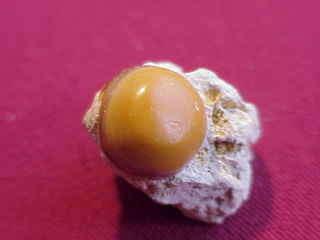
Eocene (58 – 37 million years)
Below Eocene Fish Dilpomystus (& Knigthia small)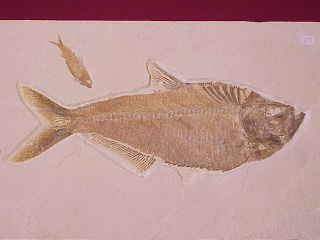
Oligocene (37 – 24 million years)
Below Oligocene Fish Dapalis macrurus & its lunch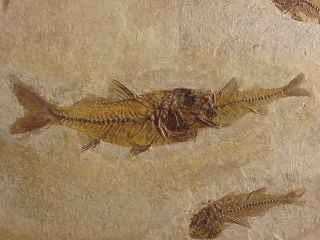
Miocene (24 – 5 million years)
Below Miocene Mega shark tooth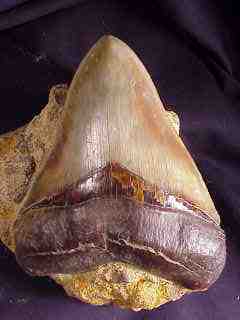
Pliocene (5 – 2.6 million years)
Below Pliocene Horse tooth Hipparion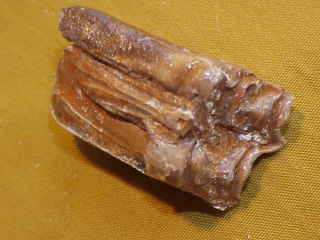
Thecontinents get their recent shape and position, although Europe and North America arestill connected at the beginning of the Tertiary, so that especially mammals can mix onboth continents.
Mostnon-dinosaurian reptiles (lizards, snakes, turtles, and crocodiles) survived the massextinction at the end of the Cretaceous. But although they had to chance to profit fromthe extinction of the dinosaurs, it were the mammals and birds that really thrived.
Mammals andbirds have a few characteristics in common. The most remarkable of these is the fact thatit are very intelligent and ingenious animals, with the ability to learn from experience.They often work together, forming herds or swarms that in some ways act as one big superorganism. And they are of course warm-blooded: they produce their own body heat, so thatthey are not dependent on outer environmental conditions. They can live in cold areas thatare too hostile for cold-blooded reptiles, which only become active after they have beenwarmed up by the sun.
ThePaleocene marks the time of the adaptive spread of the mammals. The different animalspecies that are found in the fossil deposits from this period are not very big: smallinsect eaters and some very early primates. The first big waves of herbivorous mammalsappeared in the Upper Paleocene. The carnivorous mammals are still small. The place of thebig carnivores is taken by some unusually big cursorial birds (up to 10 feet high) with avery strong beak. They die out after the first carnivorous mammals appear.
In theEcocene the mammals start to play the most important role in life on earth. They not onlydominated the ecosystems on land, they also returned to the sea (whales and dolphins) andlearned to fly (bats).
Thegeography of the earth is still changing in the Oligocene. Europe disconnects from NorthAmerica. On the Southern Hemisphere, Antarctica is covered by ice. The rodents, like rats,mice, hamsters and beavers, now prosper. The big plant eaters have a big variety. Some ofthem are more than twelve feet high. The dogs and cats (among them the saber-toothed cats)also originate in the Oligocene.
In theMiocene the dramatic explosion of the mammalian fauna continues. The South Pole extends,so that it gradually gets colder. The dense rain forests are replaced by open grass landsthat are able to feed even more mammals like horses, camels, deer, and elephants.
Because ofthe tendency to a cool and dry climate, the circumstances in the Pliocene can be comparedwith those of the present. The important vegetation types as we know them now originatedin the Pliocene. A lot of specialized animal species became extinct and were replaced byanimal types with a mixed diet that could better adapt to the changing conditions.
The mammoth
After thedinosaurs became extinct approximately 65 million years ago, the birds and especially themammals fill up the empty spaces and start an impressive march. The ancestors of themammoths emerged around 40 million years ago in Africa. These are the first proboscideans.The trunk resulted from the growing together of the nose and the upper lip. Elephants grewlarger but the neck stayed short, so a trunk was needed to bring food and water to themouth. The nostril is formed by a big hole at the point of attachment, so that the skullof elephants can easily be recognized.The first elephants evolved into more than 150different species in the course of time, some of them with very long tusks (these areactually extremely elongated incisive teeth). The bloom of the elephants was in theMiocene.
About fouror five million years ago in Africa the elephants divided into three lines. From the firstone, the Loxodonta, the African elephant emerged. The Indian elephant probably evolvedfrom the second one, Elephas. The third one, Mammuthus, gave rise to the mammoths. So, asis sometimes thought, the mammoths are not the ancestors of the current elephants.
About threemillion years ago the first mammoths appeared in Europe. They belonged to the species Mammuthusmeridionalis, also called ancestral mammoth. It was bigger than the current elephants(13 feet high, weight 10 tons), and without hair (the climate was warm then). But it hadbent tusks, which is a characteristic of mammoths. It also spread east to Asia, andcrossed the Bering Land Bridge to reach North America about 1.7 million years ago when theclimate was cold. When the temperature and thus the sea level rose again, the twocontinents were separated. In North America, the isolated M. meridionalis evolved into Mammuthuscolumbi (Columbian mammoth).
One millionyears ago the climate changed. The temperature became colder, and this changed thelandscape in Europe. Woods changed into open grasslands. M. meridionalis died out, but notbefore a small population adapted to the changing conditions and evolved into Mammuthustrogontherii (steppe mammoth). Its molars had more ridges, so that they were moresuitable for eating tough grasses.
Approximately250,000 years ago in Europe, the woolly mammoth, Mammuthus primigenius,emerged from M. trogontherii. It was even better adapted to the cold. It was about as bigas the Indian elephant (11 feet high), with a thick, long-haired woolly skin, a hypodermicfat layer, a short tail and small ears. M. primigenius is the last species of theMammuthus family. If people say ‘mammoth’, they usually refer to the woollymammoth. About 100,000 years ago the woolly mammoth was also able to reach North Americathrough the Bering Land Bridge. But its range was limited to Alaska and Canada, while M.columbi preferred a milder climate and had moved south to the US and Mexico. In the restof the world the woolly mammoth could be found in Europe and Asia.
Woollymammoths are well-known because of their finds in the Siberian permafrost (constantlyfrozen soil). The animals are often so well-preserved that even skin, flesh and hairremain. In Europe, fishing boats often find remains in their nets, especially on the NorthSea between Holland and England. In the Pleistocene era during the ice ages, the sea levelwas so low that animals (and humans) could live on the bottom of what is now the sea.
(Right Woolly Mammoth lower Jaw) 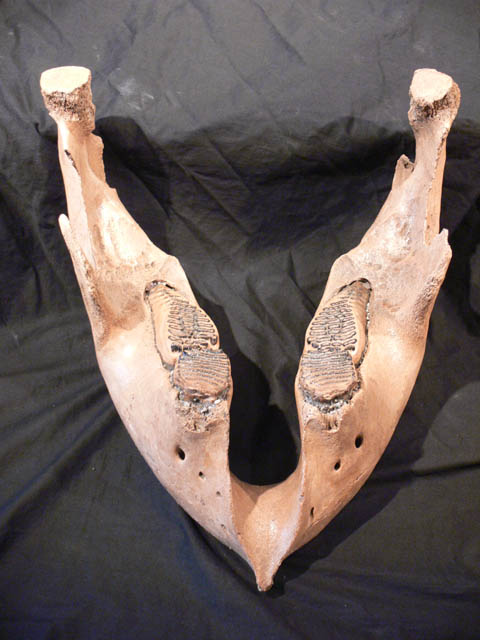
At the endof the Pleistocene, 10,000 years ago, a lot of big mammals like the cave bear, cave lion,giant deer, steppe wisent, but also the mammoth, died out. On the one hand this was causedby the changing climate (it became warmer, so that the vegetation changed), on the otherhand because of the influence of humans, which rose in number and developed more efficienthunting techniques.
Mastodontsare sometimes confused with mammoths. Mastodonts are a separate branch of the elephanttree. They emerged 35 million years ago in Africa. After that, they spread through Europeand Asia, and 3.7 million years ago to North America, where they evolved into the species Mammutamericanum. Mastodonts resemble mammoths, but were smaller.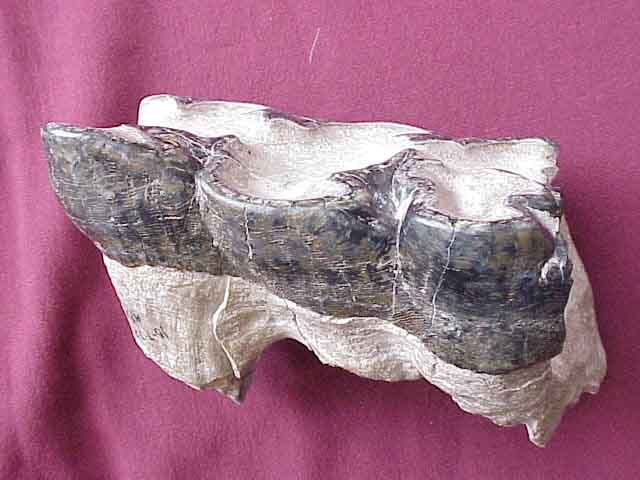 (Mastodont)
(Mastodont)
Quaternary
Pleistocene (2.6 million years – 10,000 years)
European Cave Lion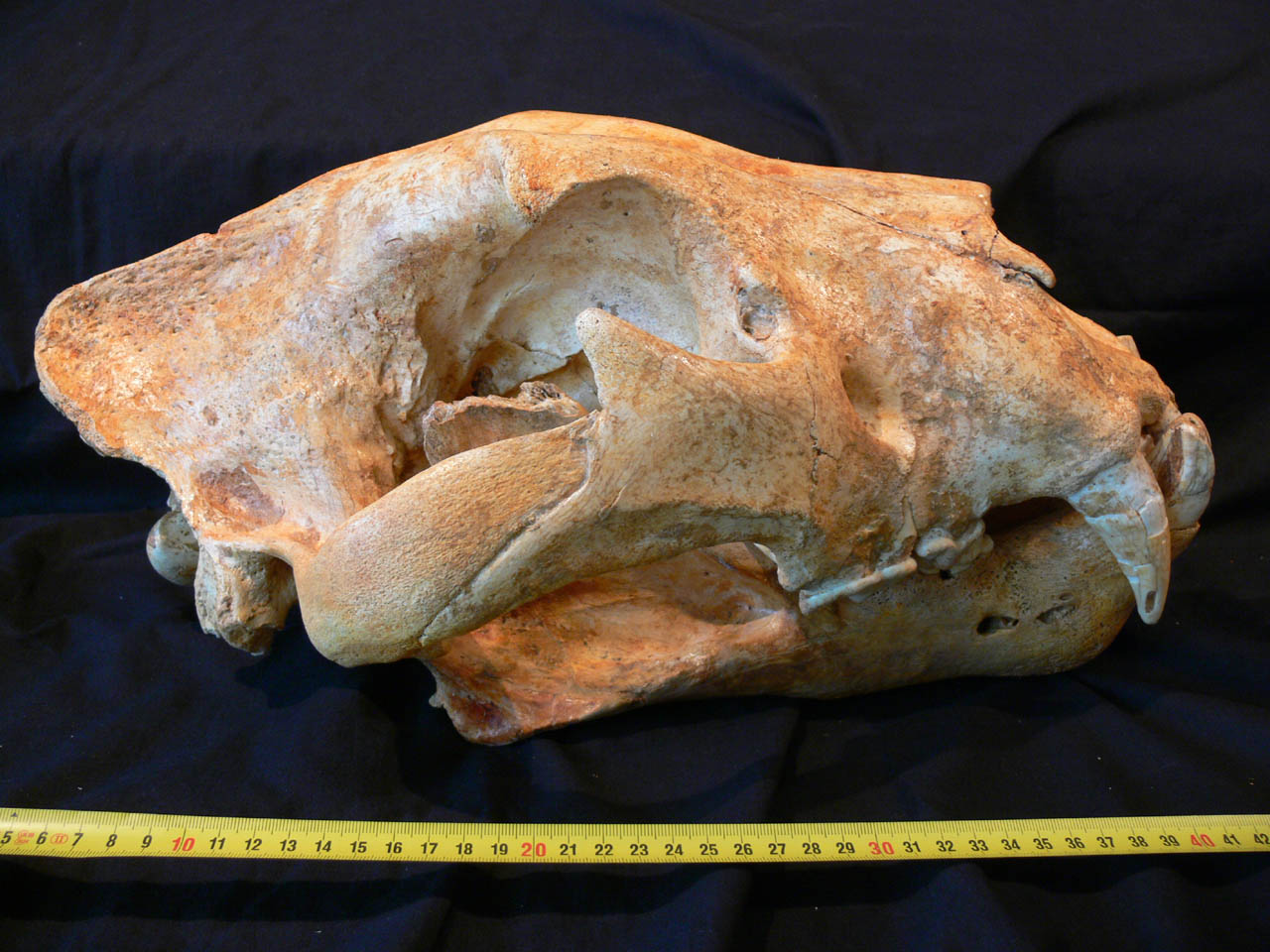
Holocene(10,000 years – recent)
ThePleistocene era is characterized by at least five important ice ages, in which the icecaps moved south in the form of enormous glaciers. The overall climate is so cold that thesnow in the north does not melt. A big part of northern Europe, Asia and North America iscovered by ice, which resulted in a worldwide climate change. However, the interglacialperiods were warm, even subtropical. The most recent ice age ended about 10,000 years ago.A lot of big mammals became extinct then, like the mammoth, mastodont, giant deer, giantsloth, woolly rhinoceros, and saber-toothed cat.
One of thereasons for these extinctions were the fast climate changes that followed when the icecaps retreated, another is the spread of the human populations across the world thathunted these animals.
Modern manbelongs to a group of animals known as primates. We now know about 200 living species. Itare mainly tree-dwelling animals. Their main characteristics are agility (great ability tomove arms and legs, and a prehensile hand), intelligence, and parental care.
The originof the big anthropoids is in the Miocene, in Africa. At the end of the Miocene they haveswarmed out across Europe and Asia. The general opinion is that the anthropoids separatedfrom the apes between seven and five million years ago and started to walk upright,probably because the tropical forests retreated and were replaced by open spaces. Becauseof the upright position they could take longer steps and quickly spot predators or food.It also made the hands free, which could now be used for carrying children, food andweapons.
Anthropoidsthat walk upright and can (thus) use their hands are called Hominids. The oldest knownHominid is Australopithecus, which originated in Africa about four million years ago. Thefirst human was Homo habilis, which evolved from Australopithecus in the Early Pleistocenein Africa. Homo habilis, in turn, evolved into Homo erectus (‘upright man’)about 1.6 million years ago in Africa. As from one million years ago he is also found inother parts of the world. He reached China and Java 800,000 years ago, and Europe 500,000years ago. The Homo erectus is the predecessor of the Homo sapiens, the modern man. One ofthe subspecies of Homo sapiens is the Neanderthal man, that lived from 200,000 to 30,000years ago.
Ourspecies, Homo sapiens sapiens, separated from Homo sapiens 100,000 years ago in Africa.Homo sapiens sapiens is the predecessor of all humans on earth. He also spread out acrossthe continents, and under the influence of the local climate and conditions, severalsubspecies originated. One of these was the Cro-Magnon, that reached Europe 40,000 yearsago. In the next 10,000 years, he displaced the Neanderthal. The Cro-Magnon is thepredecessor of the Europeans.
TheHolocene is the period that started after the last ice age. Humans start to use farming,and they learn how to manipulate ecosystems. In the stable communities that could livefrom agricultural products, a civilisation process was started that resulted in afast-growing development of biological manipulation and technology. Humans first inventedsimple tools to improve agricultural techniques. Animals were domesticated and used towork the land and to provide food and clothes. The concentrations of social groups ofhumans also resulted in a bigger complexity of interaction, and the development ofspecialized tools within the community; skills that could then be ‘sold’ inexchange for other needs. The settlement of stable communities resulted in villages andcities, and ultimately in national states. From that moment on, the world populationincreased dramatically, and, in geological terms, the technological knowledge hasprogressed in a breath-taking speed. Humans are dominating the planet in an unequalledway.
Below Homo sapiens sapiens.